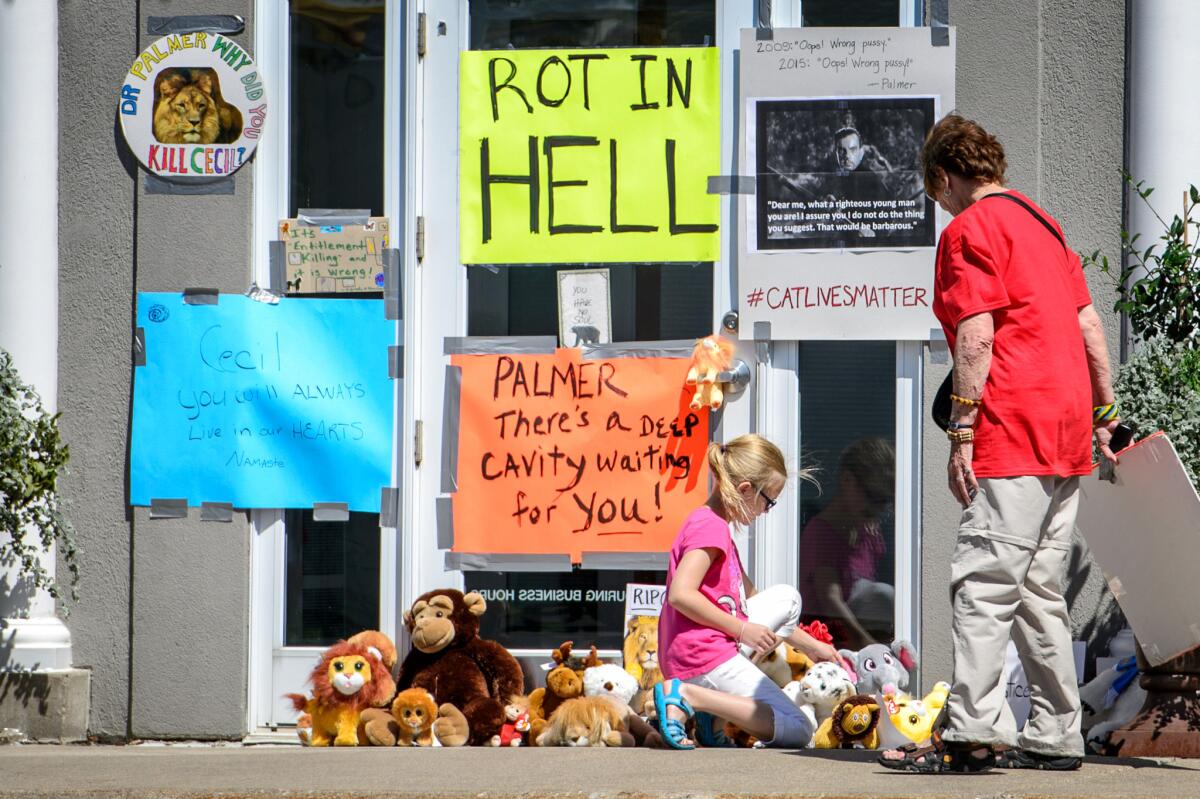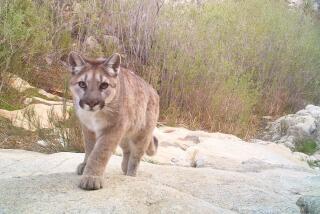The lion, the dentist and the fury: A viral storm

Protesters leave signs and stuffed animals in front of Dr. Walter Palmer’s dental practice in Bloomington, Minn., this week.
First, they tweeted his name more than 1.5 million times within 72 hours. #CeciltheLion appeared as a firestorm of colorful dots on trend maps of popular hashtags around the world, garnering about 17 tweets a minute on Tuesday morning, 860 a minute by Tuesday afternoon, and still nearly 500 a minute by noon Thursday.
“Rest in Peace Cecil,” one user mourned, in a post notable for its mild language.
“All animals go to heaven. Not so sure about humans. #CecilTheLion,” wrote another. That post, too, is civil -- unlike thousands of expletive-studded tweets too profane for a family newspaper.
NEWSLETTER: Get the day’s top headlines from Times Editor Davan Maharaj >>
When an African-based conservation group announced Monday that Walter James Palmer had killed a lion outside Zimbabwe’s Hwange National Park, the Minnesota dentist became the focus of international scorn. People were angry not only that he had killed the animal, which was a tourist attraction and had been collared for a scientific study, but that he had lured Cecil out of the safety of the park, posed for photos with his body, then skinned and beheaded it.
By Thursday, however, the backlash had become part of the story.
“He killed like half of Noah’s Ark,” said Jimmy Kimmel, who teared up during a monologue about Cecil the lion that had been viewed more than 6 million times by Thursday evening.
“How is that fun?” he said, before showing separate pictures of Palmer on other hunts next to the corpses of a lion, a bear, a leopard and a rhinoceros.
A lengthy segment on Larry Wilmore’s “The Nightly Show” included Holly Walker as “a big game hunter hunter.”
“It’s not personal,” Walker assured Wilmore. “It’s the sport.”
Jane Goodall, an English primatologist known for a 55-year study on chimpanzees in Africa, chimed in on her website: “I have no words to express my repugnance.”
On the Internet circa 2015, the revolted reaction fed on itself.
Fueled by the attention of celebrities and activists, an online mob went in for its own kill -- descending on Palmer’s online profiles until a mass of bad reviews seemed enough to keep anyone away from his Minneapolis-area dental practice.
“Went in for a cleanup, left without a head,” one reviewer wrote on River Bluff Dental’s page on Yelp.
On Facebook, more than 7,000 reviews had left Palmer with an average score of 1.2 stars out of 5.
Others Facebook users posted Palmer’s supposed cellphone number and urged people to call or text him.
And riverbluffdental.com, stormed by the angry mob, appeared to be a partially functioning artifact -- and a sign of the indisputable power of the social Web.
“There wasn’t just outrage; there was a sense of vindication,” Karen North, director of the digital social media program at USC, told the Los Angeles Times. Cecil the lion has entered the realm of people’s passions, she said.
The story began July 6, when the Zimbabwe Conservation Task Force, a local conservation activist group, alleged that Palmer and his guides spotted Cecil inside the national park on July 6 and tied a dead animal to their vehicle to lure the lion out of the park. Then, the task force said, Palmer shot Cecil with a bow and arrow, wounding him. The task force said Palmer and his guides tracked the wounded lion for 40 hours before shooting him, but cited no source for its claim. It also alleged that Palmer had paid $50,000 for the hunt.
Two Zimbabweans who arranged Palmer’s hunt, landowner Honest Trymore Ndlovu and professional hunter Theo Bronkhorst, face charges, and Zimbabwe police spokeswoman Charity Charamba said authorities are seeking Palmer too. “We arrested two people and now we are looking for Palmer in connection with the same case,” Charamba told the Associated Press.
In a statement issued early this week, Palmer said he had no idea Cecil was a “known, local favorite, was collared and part of a study.”
“I hired several professional guides and they secured all proper permits,” he said. “To my knowledge, everything about this trip was legal and properly handled and conducted.”
But by Thursday, a pile of stuffed animals guarded the sidewalk outside Palmer’s Bloomington dental office, where the doors were bolted shut.
Palmer himself appeared to have vanished.
“We’re investigating the killing of #CecilTheLion,” the Fish and Wildlife Service tweeted. “Will go where facts lead. We ask Dr. Palmer or his rep to contact USFWS immediately.”
For some analysts, his absence, and the social media reaction that caused it, was indicative of the way the Internet offers everyone a lectern and a loudspeaker, for better or worse.
“It is likely this story is emblematic of the collective rush to outrage that now leaves a mark on public policy,” said William Youmans, a professor of media and public affairs at George Washington University.
“Whether this is good or bad is hard to say,” Youmans wrote in an email. “In a way, it lessens the powers of traditional gatekeepers who defined the public agenda. That makes it feel more democratic. However, it still falls short of the standards of reasoned and informed public discourse that is the ideal of democracy.”
Dave Karpf, a professor who studies Internet politics at George Washington University, also said it showed a changing world.
“I imagine this story in 1985 would’ve maybe made the nightly news,” he told The Times in an email. “This story in 1995 or 2005 wouldn’t have been much different.”
But that was then.
“Information travels differently, and people behave differently, within the context of the social Web of 2015,” Karpf said. “The social Web rewards hot takes and outrage. It leaves the tools of vigilante justice just lying around, waiting for anyone to pick them up. And what the dentist did was outrageous. So we form up an online mob, and that creates the context for a larger and longer story.”
Twitter: @natalieschachar
Staff writers Robyn Dixon in South Africa and Connie Stewart in Los Angeles contributed to this report.
MORE ON CECIL THE LION:
Jimmy Kimmel mourns Cecil the Lion, lashes out at animal’s killer
Artist creates Cecil the lion tote bag to benefit wildlife research
Cecil the lion’s killer is not alone: Trophy hunters disproportionately Americans
More to Read
Start your day right
Sign up for Essential California for news, features and recommendations from the L.A. Times and beyond in your inbox six days a week.
You may occasionally receive promotional content from the Los Angeles Times.






